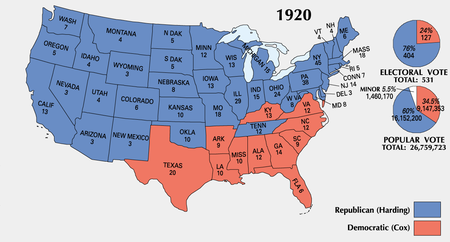U.S. presidential election, 1920
|
|
By the time of the U.S. presidential election of 1920, World War I was over. The wartime boom had collapsed. Diplomats and politicians were arguing over peace treaties and the question of America's entry into the League of Nations. Overseas there were wars and revolutions; at home there were strikes, riots, and a growing fear of radicals and terrorists. Disillusionment was in the air.
The giants who had dominated the political scene for a generation were gone -- Theodore Roosevelt died in 1919 and Woodrow Wilson was an invalid living in seclusion. Even so, the presidential election of 1920 continued the debate between the nationalistic activism of Roosevelt's presidency and the global idealism of Wilson's administration.
| Contents |
Nominations
Republican Party nomination
On June 8, 1920, the Republican National Convention meeting in Chicago nominated Warren G. Harding, an Ohio newspaper editor and United States Senator, to run for president with Calvin Coolidge, governor of Massachusetts, as his running mate. Harding was a compromise candidate after the convention deadlocked between General Leonard Wood and Governor Frank O. Lowden of Illinois. Harding campaigned as advocating, in his own phrase, "A Return to Normalcy" ("normalcy" was a corruption of "normality" and later became part of the American dialect) after the trying times of the World War.
Democratic Party nomination
The Democrats, meeting in San Francisco, nominated another newspaper editor from Ohio, Governor James M. Cox, as their presidential candidate, and thirty-seven-year-old Under-Secretary of the Navy Franklin D. Roosevelt, a fifth cousin of the late president Teddy Roosevelt, for vice president.
Other nominations
Socialist Party candidate Eugene V. Debs received 913,664 popular votes (3.4%), despite the fact that he was in prison at the time (for advocating non-compliance with the draft in World War I). Debs was later released from prison by President Harding. This was the most ever popular votes received by a Socialist Party candidate.
Parley P. Christensen of the Farmer-Labor Party took 265,229 votes (1.0%), while Prohibition Party candidate Aaron S. Watkins came in fifth with 189,339 votes (0.7%), the poorest showing for the Prohibition party since 1884; as the Eighteenth Amendment starting Prohibition had passed the previous year, this single-issue party seemed less relevant.
General election
Campaign
The election was primarily decided by the unpopularity of Wilson and the League of Nations.
On election night, November 2, 1920, commercial radio broadcast coverage of election returns for the first time. Announcers at KDKA AM, Pittsburgh, read telegraph ticker results over the air as they came in. This single station (with few competitors on the airwaves) could be heard over most of the Eastern United States by the small percentage of the population that had radio receivers.
This was the first election in which all women were allowed to vote, following the passage of the 19th Amendment to the Constitution.
Tennessee's vote for Warren G. Harding marked the first time since the end of Reconstruction that one of the 11 states of the Confederacy had voted for a Republican.
Source: Library of Congress (http://memory.loc.gov/ammem/nfhtml/nfexpe.html)
Results
Template:Start U.S. presidential ticket box Template:U.S. presidential ticket box row Template:U.S. presidential ticket box row Template:U.S. presidential ticket box row Template:U.S. presidential ticket box row Template:U.S. presidential ticket box row Template:U.S. presidential ticket box row Template:U.S. presidential ticket box row Template:U.S. presidential ticket box row Template:End U.S. presidential ticket box (a) Template:U.S. popular vote total disclaimer

